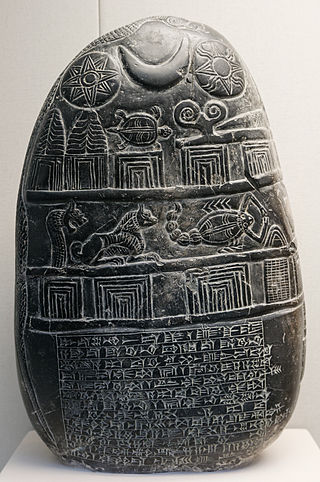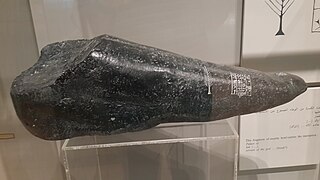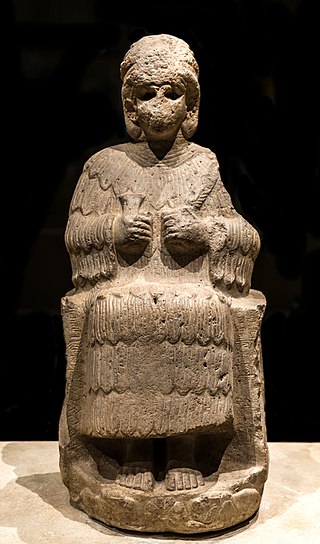Related Research Articles

Shamash, also known as Utu was the ancient Mesopotamian sun god. He was believed to see everything that happened in the world every day, and was therefore responsible for justice and protection of travelers. As a divine judge, he could be associated with the underworld. Additionally, he could serve as the god of divination, typically alongside the weather god Adad. While he was universally regarded as one of the primary gods, he was particularly venerated in Sippar and Larsa. The moon god Nanna (Sin) and his wife Ningal were regarded as his parents, while his twin sister was Inanna (Ishtar). Occasionally other goddesses, such as Manzat and Pinikir, could be regarded as his sisters too. The dawn goddess Aya (Sherida) was his wife, and multiple texts describe their daily reunions taking place on a mountain where the sun was believed to set. Among their children were Kittum, the personification of truth, dream deities such as Mamu, as well as the god Ishum. Utu's name could be used to write the names of many foreign solar deities logographically. The connection between him and the Hurrian solar god Shimige is particularly well attested, and the latter could be associated with Aya as well.

Elam was an ancient civilization centered in the far west and southwest of modern-day Iran, stretching from the lowlands of what is now Khuzestan and Ilam Province as well as a small part of southern Iraq. The modern name Elam stems from the Sumerian transliteration elam(a), along with the later Akkadian elamtu, and the Elamite haltamti. Elamite states were among the leading political forces of the Ancient Near East. In classical literature, Elam was also known as Susiana, a name derived from its capital Susa.

Shala (Šala) was a Mesopotamian goddess of weather and grain and the wife of the weather god Adad. It is assumed that she originated in northern Mesopotamia and that her name might have Hurrian origin. She was worshiped especially in Karkar and in Zabban, regarded as cult centers of her husband as well. She is first attested in the Old Babylonian period, but it is possible that an analogous Sumerian goddess, Medimsha, was already the wife of Adad's counterpart Ishkur in earlier times.
Ruhurater or Lahuratil was an Elamite deity.
Jabru was a god who according to Mesopotamian god lists was worshiped in Elam. However, he is not attested in any Elamite sources.
Humban was an Elamite god. He is already attested in the earliest sources preserving information about Elamite religion, but seemingly only grew in importance in the neo-Elamite period, in which many kings had theophoric names invoking him. He was connected with the concept of kitin, or divine protection.

Pinikir, also known as Pinigir, Pirengir, Pirinkir, and Parakaras, was an Ancient Near Eastern astral goddess who originates in Elamite religious beliefs. While she is only infrequently attested in Elamite documents, she achieved a degree of prominence in Hurrian religion. Due to her presence in pantheons of many parts of the Ancient Near East, from Anatolia to Iran, modern researchers refer to her as a "cosmopolitan deity."

Inshushinak was the tutelary god of the city of Susa in Elam. His name has a Sumerian etymology, and can be translated as "lord of Susa". He was associated with kingship, and as a result appears in the names and epithets of multiple Elamite rulers. In Susa he was the main god of the local pantheon, though his status in other parts of Elam might have been different. He was also connected with justice and the underworld. His iconography is uncertain, though it is possible snakes were his symbolic animals. Two Mesopotamian deities incorporated into Elamite tradition, Lagamal and Ishmekarab, were regarded as his assistants. He was chiefly worshiped in Susa, where multiple temples dedicated to him existed. Attestations from other Elamite cities are less common. He is also attested in Mesopotamian sources, where he could be recognized as an underworld deity or as an equivalent of Ninurta. He plays a role in the so-called Susa Funerary Texts, which despite being found in Susa were written in Akkadian and might contain instructions for the dead arriving in the underworld.

Ištaran was a Mesopotamian god who was the tutelary deity of the city of Der, a city-state located east of the Tigris, in the proximity of the borders of Elam. It is known that he was a divine judge, and his position in the Mesopotamian pantheon was most likely high, but much about his character remains uncertain. He was associated with snakes, especially with the snake god Nirah, and it is possible that he could be depicted in a partially or fully serpentine form himself. He is first attested in the Early Dynastic period in royal inscriptions and theophoric names. He appears in sources from the reign of many later dynasties as well. When Der attained independence after the Ur III period, local rulers were considered representatives of Ištaran. In later times, he retained his position in Der, and multiple times his statue was carried away by Assyrians to secure the loyalty of the population of the city.
Aya was a Mesopotamian goddess associated with dawn. Multiple variant names were attributed to her in god lists. She was regarded as the wife of Shamash, the sun god. She was worshiped alongside her husband in Sippar. Multiple royal inscriptions pertaining to this city mention her. She was also associated with the Nadītu community inhabiting it. She is less well attested in the other cult center of Shamash, Larsa, though she was venerated there as well. Additional attestations are available from Uruk, Mari and Assur. Aya was also incorporated into Hurrian religion, and in this context she appears as the wife of Shamash's counterpart Šimige.
Gibil (𒀭𒉈𒄀), also known under the Akkadian name Girra, was a Mesopotamian god associated with fire, both in its positive and negative aspects. He also played a role in ritual purification. Textual sources indicate his symbol was a torch, though no representations of him have been identified in Mesopotamian art. Multiple genealogies could be assigned to him. The god list An = Anum indicates his spouse was Ninirigal. He was also frequently associated with deities such as Shamash, Nuska and Kusu. He is first attested in Early Dynastic texts from Shuruppak, such as offering lists. He was also a member of the pantheon of Eridu. In the Kassite period he was worshiped in Nippur. Later attestations are available from Assyria and from Uruk. He also appears in a number of literary texts.

Kiririsha was a major goddess worshiped in Elam.

Inzak was the main god of the pantheon of Dilmun. The precise origin of his name remains a matter of scholarly debate. He might have been associated with date palms. His cult center was Agarum, and he is invoked as the god of this location in inscriptions of Dilmunite kings. His spouse was the goddess Meskilak. A further deity who might have fulfilled this role was dPA.NI.PA, known from texts from Failaka Island.
Napirisha was a major Elamite deity. He likely originated from Anshan.

Narundi or Narunde was an Elamite goddess worshiped in Susa. She is attested there roughly between 2250 BCE and 1800 BCE. Multiple inscriptions mention her, and it assumed she was a popular deity at the time. In later periods, she occurs exclusively in Mesopotamia, where she played a role in apotropaic rituals in association with the Sebitti. Many attestations are available from late Assyrian sources, but it is not certain if they should be regarded as an indication of continuous worship.
Manzat (Manzât), also spelled Mazzi'at, Manzi'at and Mazzêt, sometimes known by the Sumerian name Tiranna (dTIR.AN.NA) was a Mesopotamian and Elamite goddess representing the rainbow. She was also believed to be responsible for the prosperity of cities.
Simut or Šimut (Shimut) was an Elamite god. He was regarded as the herald of the gods, and was associated with the planet Mars. He was closely associated with Manzat, a goddess representing the rainbow. He appears in inscriptions of various Elamite kings which mention a number of temples dedicated to him. However, it is not known which city served as his main cult center. He was also worshiped in Mesopotamia, where he was compared with the war god Nergal.
Lagamal or Lagamar was a Mesopotamian deity associated chiefly with Dilbat. A female form of Lagamal was worshiped in Terqa on the Euphrates in Upper Mesopotamia. The male Lagamal was also at some point introduced to the pantheon of Susa in Elam.
Ishmekarab (Išmekarab) or Ishnikarab (Išnikarab) was a Mesopotamian deity of justice. The name is commonly translated from Akkadian as "he heard the prayer," but Ishmekarab's gender is uncertain and opinions of researchers on whether the deity was male or female vary.
Kittum, also known as Niĝgina, was a Mesopotamian goddess who was regarded as the embodiment of truth. She belonged to the circle of the sun god Utu/Shamash and was associated with law and justice.
References
- 1 2 Stolper 1998, p. 82.
- ↑ Stolper 1998, pp. 82–83.
- 1 2 3 4 5 6 7 8 9 Stolper 1998, p. 83.
- ↑ Stolper 1998, pp. 83–84.
- ↑ Álvarez-Mon 2015, p. 19.
- ↑ Henkelman 2008, p. 313.
- 1 2 3 4 5 6 Stolper 1998, p. 84.
- ↑ Stolper 1998a, p. 84.
- ↑ Rutherford 2019, p. 84.
- ↑ Krebernik 1997, p. 364.
- 1 2 Potts 2010, p. 492.
- ↑ Henkelman 2008, p. 239.
- ↑ Henkelman 2008, p. 315.
- ↑ Henkelman 2008, p. 390.
Bibliography
- Álvarez-Mon, Javier (2015). "Like a thunderstorm: storm-gods 'Sibitti' warriors from Highland Elam". AION: Annali dell'Università degli Studi di Napoli "L'Orientale". 74 (1–4): 17–46. ISSN 0393-3180 . Retrieved 2022-04-15.
- Henkelman, Wouter F. M. (2008). The other gods who are: studies in Elamite-Iranian acculturation based on the Persepolis fortification texts. Leiden: Nederlands Instituut voor het Nabije Oosten. ISBN 978-90-6258-414-7.
- Krebernik, Manfred (1997), "Mondgott A. I. In Mesopotamien", Reallexikon der Assyriologie (in German), retrieved 2022-04-15
- Potts, Daniel T. (2010). "Elamite Temple Building". From the foundations to the crenellations: essays on temple building in the Ancient Near East and Hebrew Bible. Münster: Ugarit-Verlag. ISBN 978-3-86835-031-9. OCLC 618338811.
- Rutherford, Ian (2019). "Gods of the Market Place". Economy of Religions in Anatolia and Northern Syria. Ugarit-Verlag. doi:10.2307/j.ctv1t4m1xv.11.
- Stolper, Matthew W. (1998), "Nahhunte", Reallexikon der Assyriologie, retrieved 2022-04-15
- Stolper, Matthew W. (1998a), "Nahhunte-utu", Reallexikon der Assyriologie, retrieved 2022-04-15